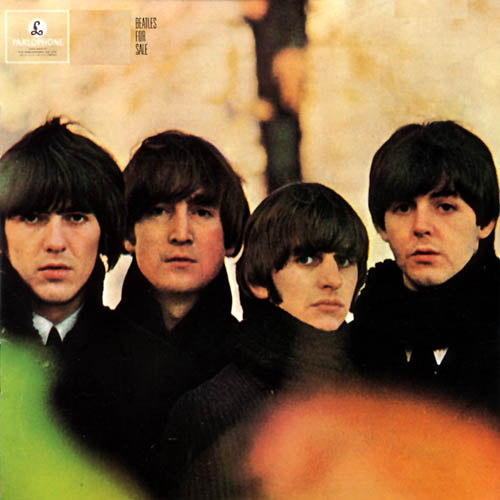
Beatles For Sale (1964)

1.No Reply
2.I'm A Loser
3.Baby's In Black
4.Rock & Roll Music
5.I'll Follow The Sun
6.Mr. Moonlight
7.Kansas City / Hey-Hey-Hey
8.Eight Days A Week
9.Words Of Love
10.Honey Don't
11.Every Little Thing
12.I Don't Want To Spoil The Party
13.What You're Doing
14.Everybody's Trying To Be My Baby
By late 1964, Beatlemania was no longer an upward trajectory—it was a cultural saturation point. The Beatles were under relentless pressure: global tours, press engagements, film commitments, and back-to-back albums left little time for rest, let alone reflection. That exhaustion is captured, perhaps more clearly than intended, on the cover of Beatles for Sale, where the four appear weary, withdrawn, and conspicuously unstyled. The image, as it turns out, is not misleading.
This fourth album, released just months after A Hard Day’s Night, shows signs of strain—albeit strain from an extraordinarily high plateau. While far from a misfire, Beatles for Sale feels transitional, with the band reverting to old habits (notably the reintroduction of cover songs) even as their songwriting continues to mature.
The most memorable original here is Eight Days a Week, an undeniably catchy McCartney-led track that became a number-one hit in the United States despite never being released as a single in the UK. It’s a rare example from this album that sounds effortless. Elsewhere, I’ll Follow the Sun (a McCartney tune written in his teens) and Every Little Thing exhibit a refined simplicity, their charm lying in understatement rather than exuberance.
The covers, while numerous, are not filler. If anything, they’re among the strongest on offer. The band’s take on Rock and Roll Music is an unapologetically aggressive Lennon vocal showcase, while Kansas City/Hey-Hey-Hey-Hey! captures the band’s enduring affection for early American rock ’n’ roll. George Harrison fronts a sprightly Everybody’s Trying to Be My Baby, a Carl Perkins number delivered with obvious relish, and Ringo Starr’s turn on Honey Don’t offers a genial, if unremarkable, diversion.
Not all tracks rise to this level. Baby’s in Black, though frequently praised for its harmonies, suffers from its 3/4 rhythm that feels awkwardly executed, giving the piece a lurching quality. More divisive still is Mr. Moonlight, a cover that veers into near-parody with its over-the-top organ stabs and exaggerated phrasing—proof, perhaps, that even the Beatles had stylistic limits.
Yet, despite its inconsistencies, Beatles for Sale remains a worthwhile listen. It captures a band in flux—still rooted in their stage-era sensibilities, yet increasingly drawn toward deeper introspection and broader musical ambition. Lennon’s lyrics, particularly on songs like I’m a Loser, hint at the personal confessions and emotional complexity that would soon define the next phase of their career.
To dismiss this record as mere filler between better moments is to miss its context. Yes, it lacks the unity of A Hard Day’s Night and the ambition of Rubber Soul, but it speaks volumes about the pressures of stardom and the band’s effort to meet demand without abandoning craft. If the Beatles stumbled here, they did so with more poise and originality than most bands could muster at full gallop.
Go back to the main page
Go To Next Review